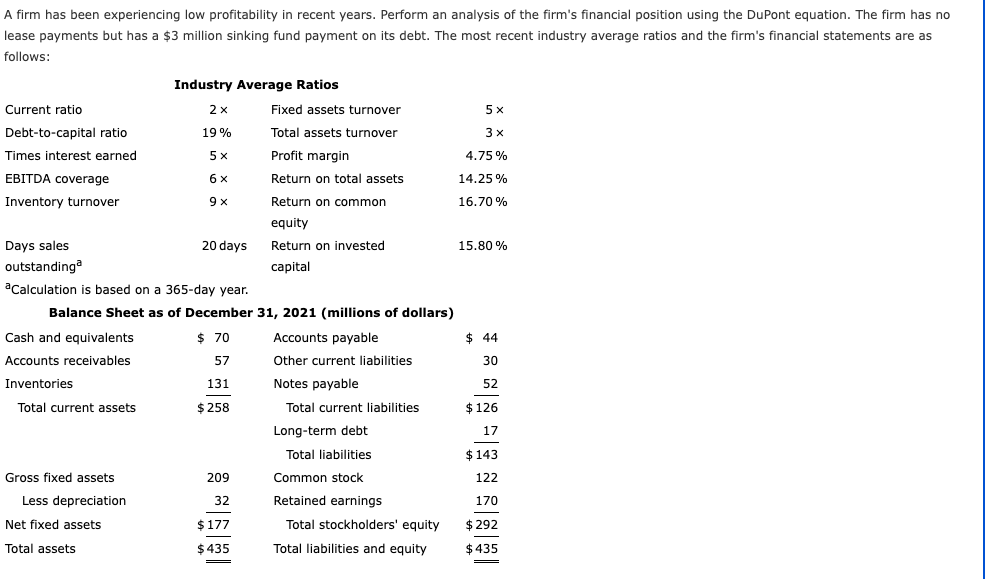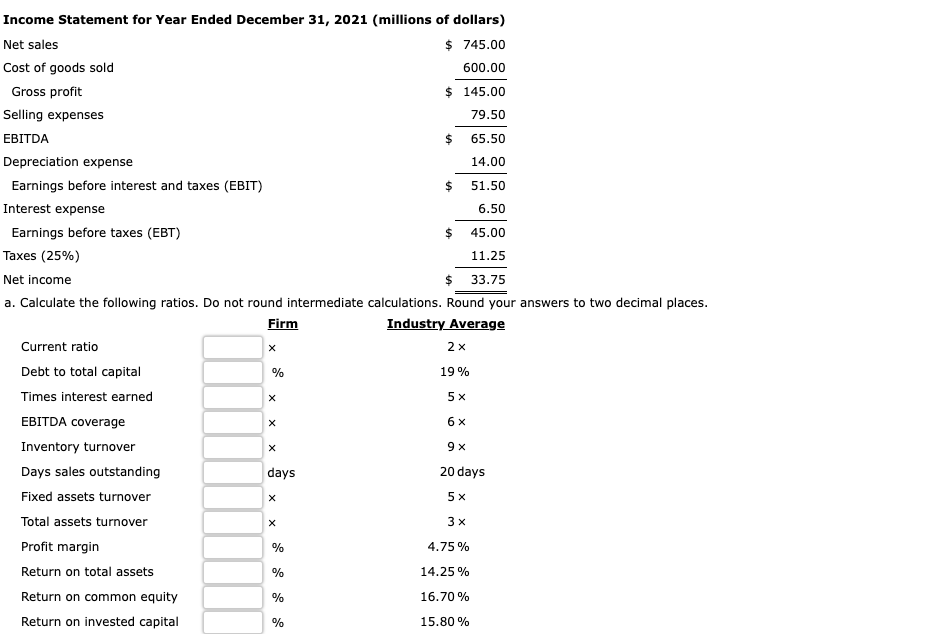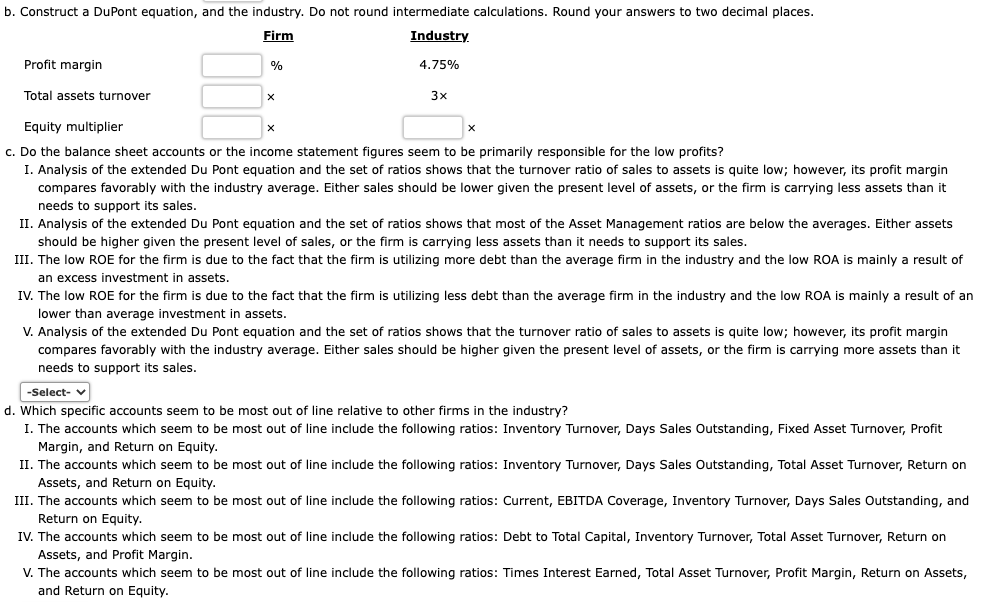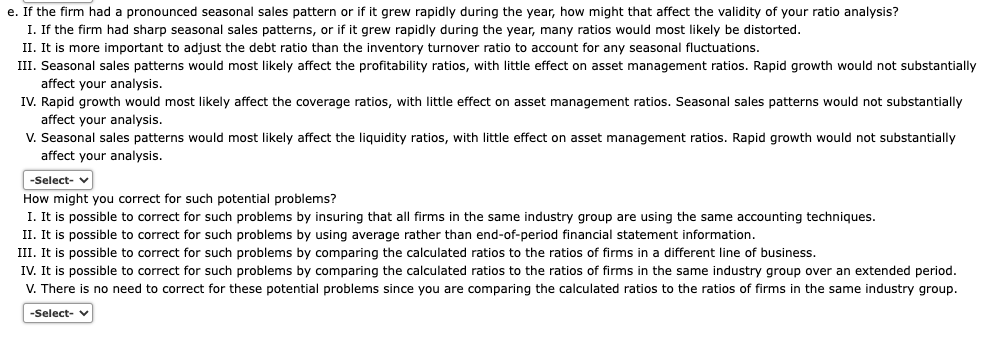



A firm has been experiencing low profitability in recent years. Perform an analysis of the firm's financial position using the DuPont equation. The firm has no lease payments but has a $3 million sinking fund payment on its debt. The most recent industry average ratios and the firm's financial statements are as follows: Industry Average Ratios Current ratio 2x 2 x Fixed assets turnover 5 x Debt-to-capital ratio - 19% % Total assets turnover 3 x Times interest earned 5 x Profit margin 4.75 % EBITDA coverage 6 x Return on total assets 14.25% Inventory turnover 9x Return on common 16.70 % equity Days sales 20 days Return on invested 15.80 % outstandinga capital Calculation is based on a 365-day year. Balance Sheet as of December 31, 2021 (millions of dollars) Cash and equivalents $ 70 Accounts payable $ 44 Accounts receivables 57 Other current liabilities 30 Inventories 131 Notes payable 52 Total current assets $ 258 Total current liabilities $ 126 Long-term debt 17 Total liabilities $ 143 Gross fixed assets 209 Common stock 122 Less depreciation 32 Retained earnings 170 Net fixed assets $ 177 Total stockholders' equity $ 292 Total assets $ 435 Total liabilities and equity $ 435 Income Statement for Year Ended December 31, 2021 (millions of dollars) Net sales $ 745.00 Cost of goods sold 600.00 Gross profit $ 145.00 Selling expenses 79.50 EBITDA $ 65.50 Depreciation expense 14.00 Earnings before interest and taxes (EBIT) $ 51.50 Interest expense 6.50 Earnings before taxes (EBT) 45.00 Taxes (25%) 11.25 Net income $ 33.75 a. Calculate the following ratios. Do not round intermediate calculations. Round your answers to two decimal places. Firm Industry Average Current ratio 2x Debt to total capital % 19 % Times interest earned 5 x EBITDA coverage 6 x Inventory turnover 9x Days sales outstanding days 20 days Fixed assets turnover Total assets turnover 3 x Profit margin % 4.75% Return on total assets % 14.25% Return on common equity % 16.70 % Return on invested capital % 15.80 % X X X X x X 5 x X b. Construct a DuPont equation, and the industry. Do not round intermediate calculations. Round your answers to two decimal places. Firm Industry. Profit margin % 4.75% Total assets turnover 3x X Equity multiplier c. Do the balance sheet accounts or the income statement figures seem to be primarily responsible for the low profits? I. Analysis of the extended Du Pont equation and the set of ratios shows that the turnover ratio of sales to assets is quite low; however, its profit margin compares favorably with the industry average. Either sales should be lower given the present level of assets, or the firm is carrying less assets than it needs to support its sales. II. Analysis of the extended Du Pont equation and the set of ratios shows that most of the Asset Management ratios are below the averages. Either assets should be higher given the present level of sales, or the firm is carrying less assets than i needs to support its sales. III. The low ROE for the firm is due to the fact that the firm is utilizing more debt than the average firm in the industry and the low ROA is mainly result of an excess investment in assets. IV. The low ROE for the firm is due to the fact that the firm is utilizing less debt than the average firm in the industry and the low ROA is mainly a result of an lower than average investment in assets. V. Analysis of the extended Du Pont equation and the set of ratios shows that the turnover ratio of sales to assets is quite low; however, its profit margin compares favorably with the industry average. Either sales should be higher given the present level of assets, or the firm is carrying more assets than it needs to support its sales. -Select- d. Which specific accounts seem to be most out of line relative to other firms in the industry? I. The accounts which seem to be most out of line include the following ratios: Inventory Turnover, Days Sales Outstanding, Fixed Asset Turnover, Profit Margin, and Return on Equity. II. The accounts which seem to be most out of line include the following ratios: Inventory Turnover, Days Sales Outstanding, Total Asset Turnover, Return on Assets, and Return on Equity. III. The accounts which seem to be most out of line include the following ratios: Current, EBITDA Coverage, Inventory Turnover, Days Sales Outstanding, and Return on Equity. IV. The accounts which seem to be most out of line include the following ratios: Debt to Total Capital, Inventory Turnover, Total Asset Turnover, Return on Assets, and Profit Margin. V. The accounts which seem to be most out of line include the following ratios: Times Interest Earned, Total Asset Turnover, Profit Margin, Return on Assets, and Return on Equity. e. If the firm had a pronounced seasonal sales pattern or if it grew rapidly during the year, how might that affect the validity of your ratio analysis? I. If the firm had sharp seasonal sales patterns, or if it grew rapidly during the year, many ratios would most likely be distorted. II. It is more important to adjust the debt ratio than the inventory turnover ratio to account for any seasonal fluctuations. III. Seasonal sales patterns would most likely affect the profitability ratios, with little effect on asset management ratios. Rapid growth would not substantially affect your analysis. IV. Rapid growth would most likely affect the coverage ratios, with little effect on asset management ratios. Seasonal sales patterns would not substantially affect your analysis. V. Seasonal sales patterns would most likely affect the liquidity ratios, with little effect on asset management ratios. Rapid growth would not substantially affect your analysis. -Select- How might you correct for such potential problems? I. It is possible to correct for such problems by insuring that all firms in the same industry group are using the same accounting techniques. II. It is possible to correct for such problems by using average rather than end-of-period financial statement information. III. It is possible to correct for such problems by comparing the calculated ratios to the ratios of firms in a different line of business. IV. It is possible to correct for such problems by comparing the calculated ratios to the ratios of firms in the same industry group over an extended period. V. There is no need to correct for these potential problems since you are comparing the calculated ratios to the ratios of firms in the same industry group. -Select










